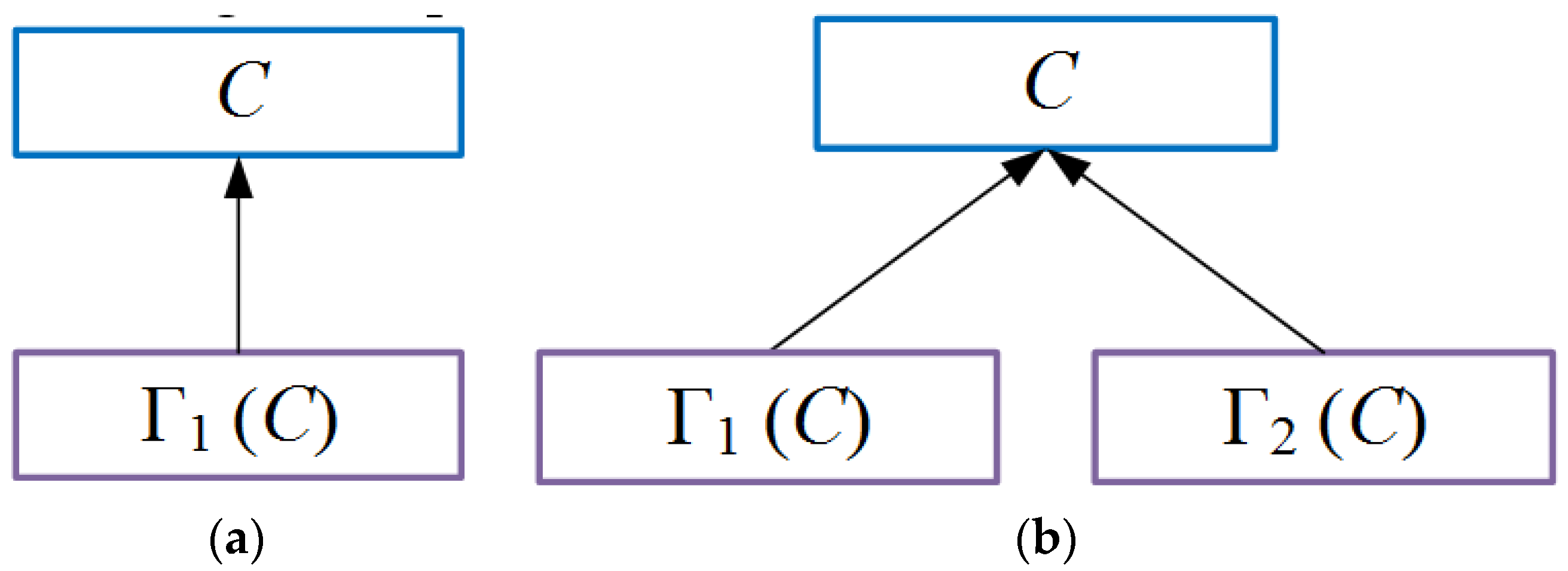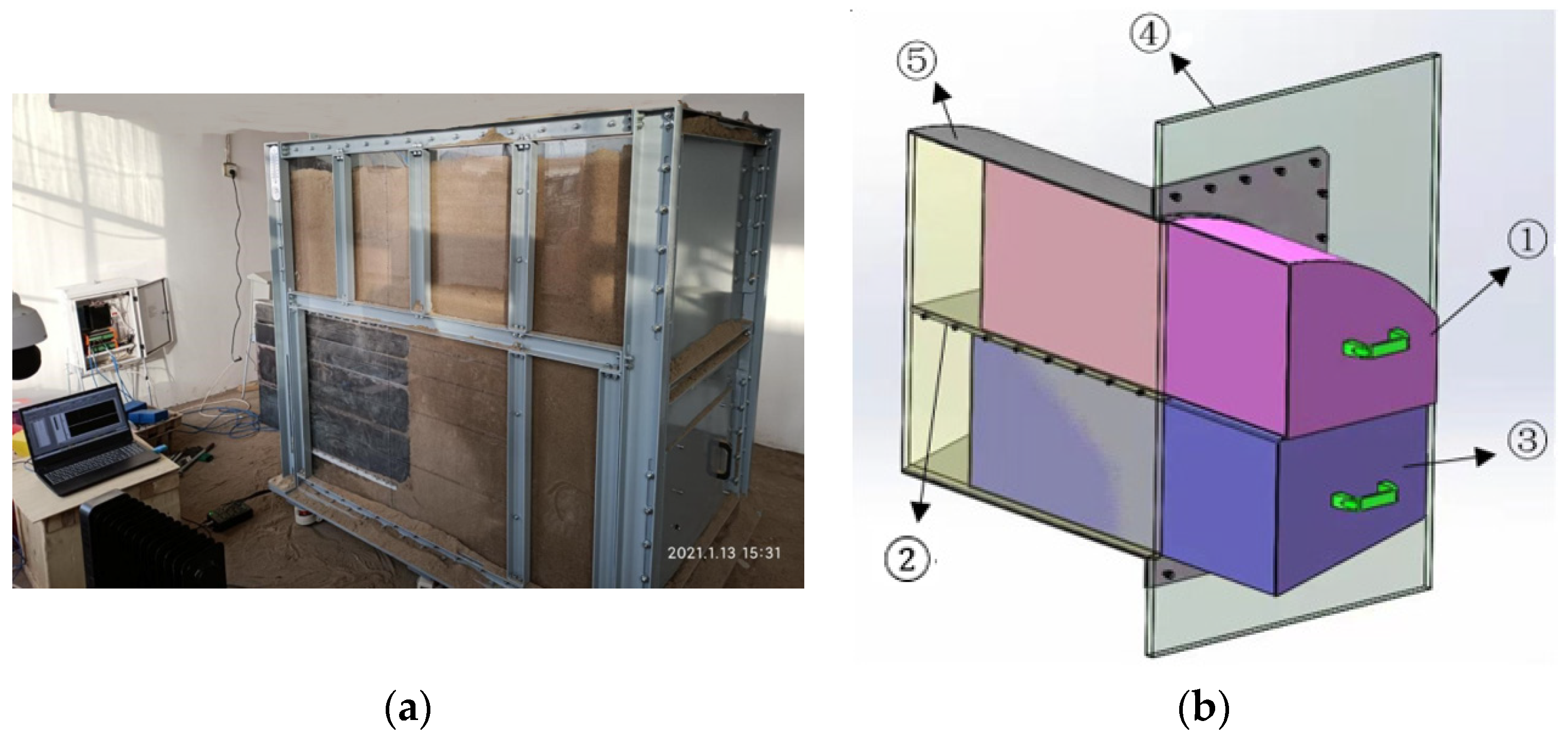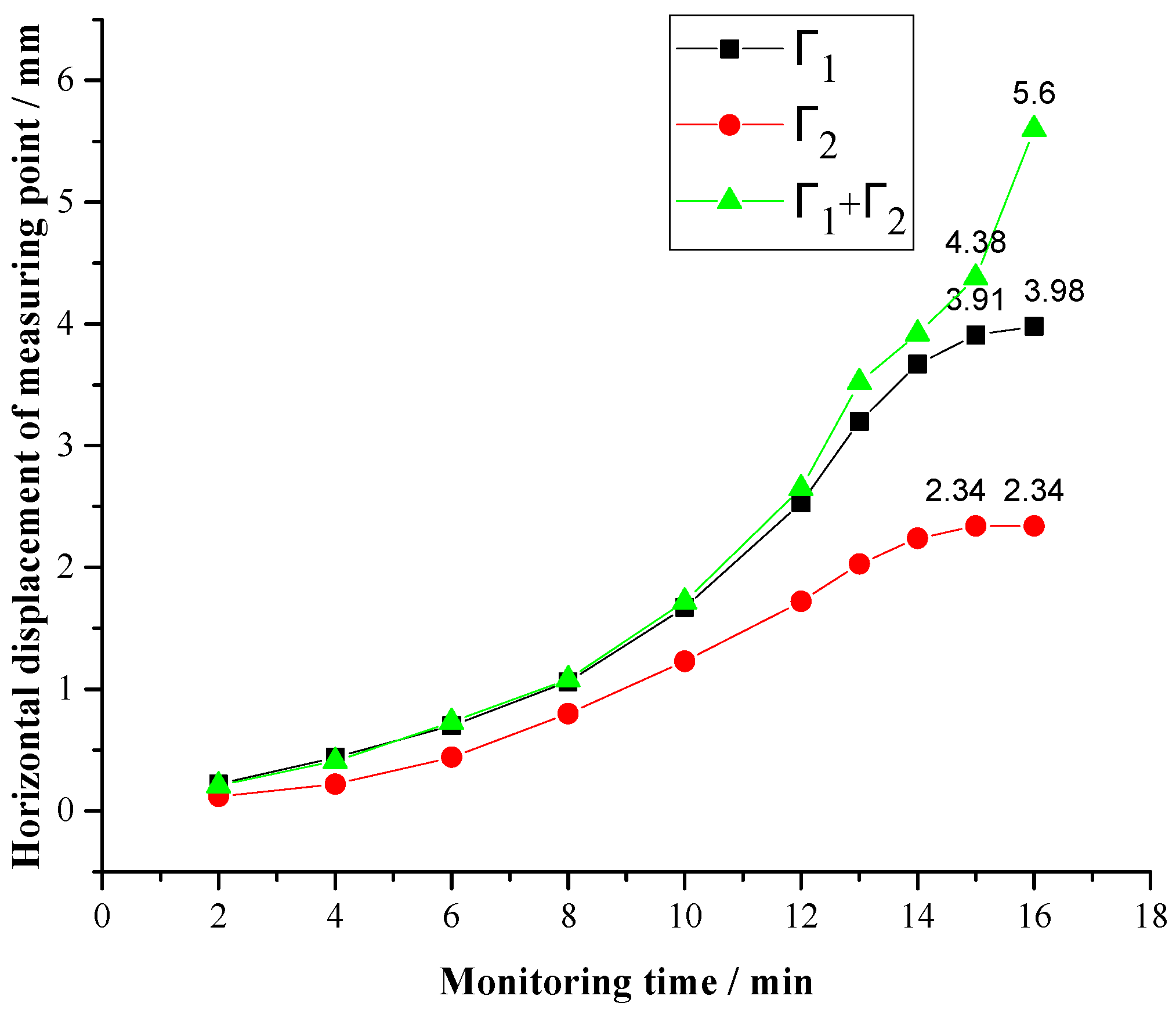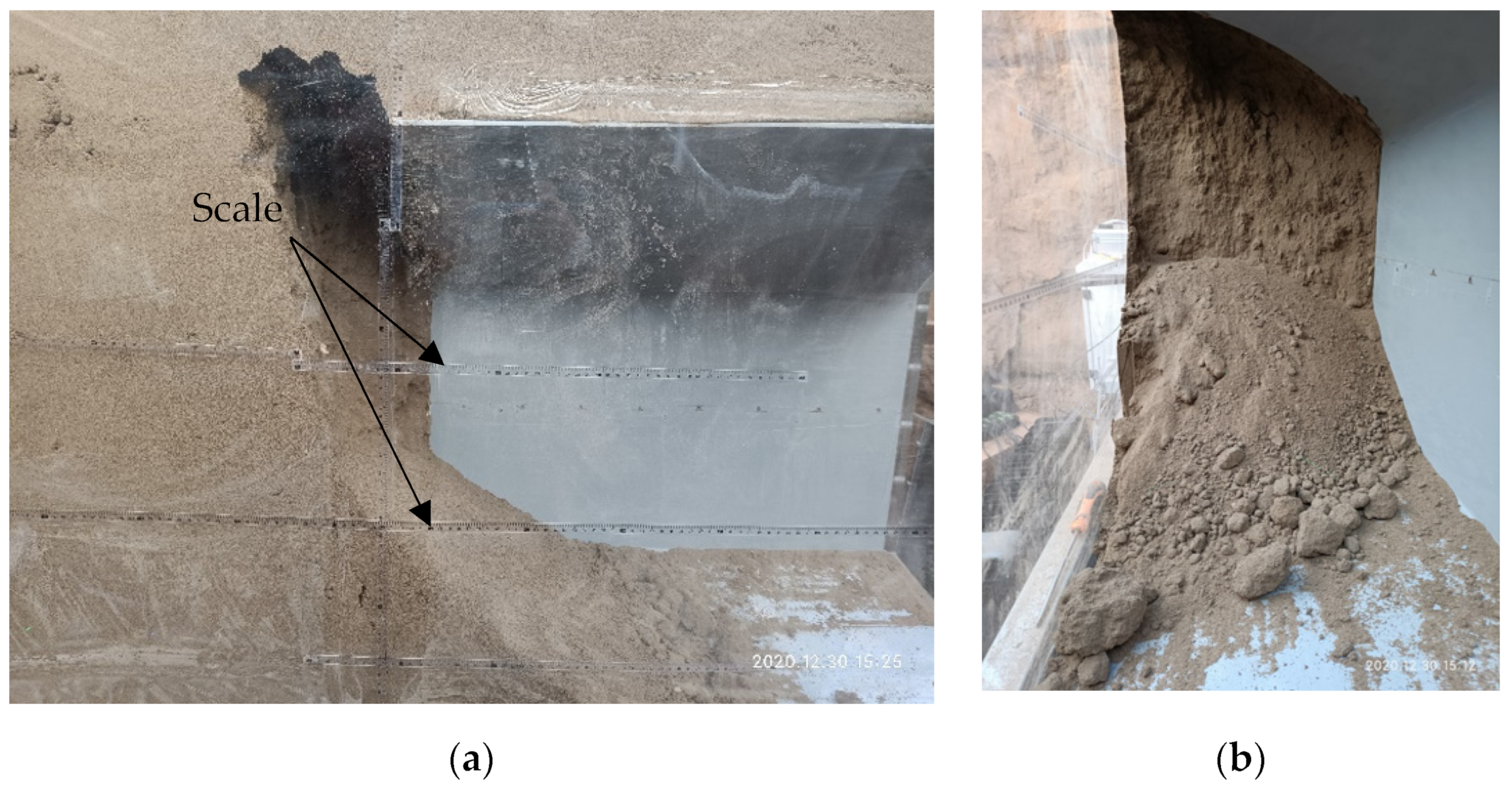Risk Assessment of Tunnel Face Instability under Multi Factor Coupling Based on Conditional Probability and Tunnel Construction Mechanics
Abstract
:1. Introduction
2. Coupling Mechanism of Risk Factors in Tunnel Construction
2.1. Definition of Risk Factor Coupling in Tunnel Construction
2.2. Analysis on the Coupling Mechanism of Risk Factors
3. Calculation Method of Risk Factor Coupling Coefficient
3.1. Basic Assumptions of Risk Factor Coupling Coefficient
3.2. Calculation Formula of Risk Factor Coupling Coefficient
- (1)
- When the coupling coefficient is 1, it means that the coupling effect is great, so that Γ1 and Γ2. When it happens together, C almost becomes an inevitable event.
- (2)
- When the coupling coefficient is 0, it represents no coupling effect, Γ1 and Γ2 co-occurrence or single occurrence has the same impact on C.
4. Conversion Calculation between Monitoring Data and Risk Probability
5. Determination of Extrusion Deformation Limit Value of Tunnel Face
5.1. Experimental Model Design
5.2. Test Process
- (1)
- Assemble the box and install the tunnel lining.
- (2)
- Fill the soil in layers and compact it. The filling height is 10 cm. Fill it to the top of the test area. After filling, it will stand for three days.
- (3)
- Extract the pilot tunnel block at a uniform speed and retreat to the specified position to realize the gradual release of in-situ stress. Observe the deformation and instability of the tunnel face and record it. Simulate three working conditions, observe and record the variation law of extrusion deformation of tunnel face under each working condition.
5.3. Analysis of Test Results
6. Conclusions
- (1)
- The coupling of tunnel construction risk factors is a nonlinear mechanical effect caused by the interaction of multiple factors. It has the effect of coupling amplifi-cation and coupling reduction. The coupling amplification effect is disadvantageous to the safety of tunnel construction, which is the focus of research.
- (2)
- In tunnel engineering, the risk factors transmit the risk flow to the risk carrier through the surrounding rock. Multiple risk factors produce risk coupling amplification effect by influencing other risk factors or changing the physical and mechanical parameters of surrounding rock, which eventually leads to the occurrence of tunnel construction accidents.
- (3)
- In this paper, the quantifiable and monitorable tunnel face extrusion deformation is linked with the risk probability, which can quantitatively analyze the risk probability of tunnel face collapse under the coupling of multiple factors. Under the coupling action of multiple factors, a measurable deformation index of the tunnel has a small increment, and its risk probability may have a grade transition. For example, if full face excavation Γ 1 and initial support are not closed in time Γ 2 these two risk factors appear at the same time. The extrusion deformation of tunnel face has only increased by 1.62 mm, but the risk of face collapse has increased sharply, and the risk level has jumped from level 3 to level 4.
- (4)
- This paper presents the calculation method of the coupling coefficient of two risk factors, which can quantitatively evaluate the coupling effect between the two risk factors. For the risk event of tunnel face collapse, the coupling amplification coefficient of the two risk factors of full section excavation and initial support not closed in time is 0.97, which has a strong coupling effect and amplification effect.
Author Contributions
Funding
Institutional Review Board Statement
Informed Consent Statement
Data Availability Statement
Conflicts of Interest
References
- Leca, E.; Dormieux, L. Upper and lower bound solutions for the face stability of shallow circular tunnel in frictional material. Geotechnique 1990, 40, 581–606. [Google Scholar] [CrossRef] [Green Version]
- Soubral, A.H. Three-dimensional face stability analysis of shallow circular tunnels In Proceedings of the International Conference on Geotechnical and Geological Engineering, Melbourne, Australia, 19–24 November 2000.
- Mollon, G.; Dias, D.; Soubra, A.H. Face Stability Analysis of Circular Tunnels Driven by a Pressurized Shield. J. Geotech. Geoenviron. Eng. 2010, 136, 215–229. [Google Scholar] [CrossRef] [Green Version]
- Hernández, Y.Z.; Farfán, A.D.; Assis, A.P. Three-dimensional analysis of excavation face stability of shallow tunnels. Tunn. Undergr. Space Technol. 2019, 92, 103062. [Google Scholar] [CrossRef]
- Murayama, S.; Endo, M.; Hashiba, T.; Yamamoto, K.; Sasaki, H. Geotechnical aspects for the excavating performance of the shield machines. In Proceedings of the 21st Annual Lecture in Meeting of Japan Society of Civil Engineers, Tokyo, Japan, 1966. [Google Scholar]
- Jancsecs, S.; Steiner, W. Face support for a large mix-shield in hrterogeneous ground conditions. In Proceedings of the Institute of Mining and Metallurgy and British Tunneling Society, London, UK, 5–7 July 1994; pp. 531–549. [Google Scholar]
- Broere, W. Tunnel Face Stability and New CPT Applications; Delft University of Technology: Delft, The Netherlands, 2001. [Google Scholar]
- Wei, G.; Feng, H. Calculation of minimum support pressure of pipe jacking excavation face in sandy soil. J. Undergr. Space Eng. 2007, 5, 903–908. [Google Scholar]
- Mingfeng, L.; Limin, P.; Chenghua, S. Calculation and analysis of ultimate support force of shield tunnel excavation face under the condition of facing slope. J. Geotech. Eng. 2010, 32, 488–492. [Google Scholar]
- Jinli, Q.; Yitong, Z.; Jian, G. Stability analysis of excavation face of multi-layer soil shield tunnel considering seepage. Rock Soil Mech. 2010, 31, 1497–1502. [Google Scholar]
- Wenting, H.; Xilin, L.; Maosong, H. Three dimensional limit equilibrium solution of limit support pressure on excavation face of shield tunnel. J. Undergr. Space Eng. 2011, 7, 853–856. [Google Scholar]
- Zheng, C.; Ping, H.; Dumin, Y. Upper limit analysis of tunnel face stability under advanced support. Rock Soil Mech. 2019, 40, 2154–2162. [Google Scholar]
- Kan, H.; Yonglin, A.; Jian, Y. Influence of seepage force on tunnel face stability of NATM tunnel. J. Cent. South Univ. 2019, 50, 1221–1228. [Google Scholar]
- Jianglin, Z. Study on Stability of Tunnel Face with Large Section in Shallow Broken Section; Hunan University of Science and Technology: Xiangtan, China, 2019. [Google Scholar]
- Hanyuan, L. Stability analysis of shallow tunnel face under pure clay condition. J. Railw. Sci. Eng. 2020, 17, 3150–3156. [Google Scholar]
- Xiuying, W.; Kai, L.; Lijuan, W.; Weihan, Z.; Xindong, W. Study on ultimate support pressure of tunnel face in soft surrounding rock. Railw. Trans. 2019, 41, 110–117. [Google Scholar]
- Bingyong, W.; Jianqi, W.; Weixing, W.; Weijun, M. Study on tunnel face instability mechanism of shallow buried large section tunnel in Loess Plateau. J. Railw. Eng. 2020, 37, 67–72. [Google Scholar]
- Mingnian, W.; Xiao, Z.; Siguang, Z.; Zhilong, W.; Dagang, L.; Jianjun, T. Study on design method of advance support system for mechanized full section construction of tunnel in soft surrounding rock. Railw. Trans. 2020, 42, 146–154. [Google Scholar]
- Kirsch, A. Experimental investigation of face stability of shallow tunnels in sand. Acta Geotech. 2010, 5, 43–62. [Google Scholar] [CrossRef] [Green Version]
- Jun, D.; Zhirong, M.; Lilei, F.; Yongzhao, C. Study on stability of tunnel face in shallow soft surrounding rock based on strength reduction method. Mod. Tunn. Technol. 2020, 57, 51–57. [Google Scholar]
- Jianjun, T. Study on failure mode and influencing factors of tunnel face in sandy surrounding rock. Subgrade Eng. 2010, 4, 72–74. [Google Scholar]
- Zhang, Z.; Jin, X.; Luo, W. Numerical Study on the Collapse Behaviors of Shallow Tunnel Faces under Open-Face Excavation Condition Using Mesh-Free Method. J. Eng. Mech. 2019, 145, 04019085. [Google Scholar] [CrossRef]
- Peisong, G. Study on Safety Review of Subway Station Construction Scheme; Huazhong University of Science and Technology: Wuhan, China, 2016. [Google Scholar]




| Number | Describe |
|---|---|
| 1 | When the risk factors (Γ) do not exist, the system risk is 0. |
| 2 | When a risk factor changes from non-occurrence to occurrence, the risk of the system will not be reduced. |
| 3 | Under the same objective situation, the risk of the system remains unchanged and has nothing to do with the result of causal analysis. |
| 4 | When the state of all factors is unknown, the risk of a system will not be reduced after adding risk factors to the system without considering the coupling effect. |
| Omen Event | Loss Event | Evaluation Value |
|---|---|---|
| [0, 79%] Alarm value | Impossible | [0, 10) |
| Rare | [10, 100) | |
| Occasionally | [100, 1000) | |
| [80%, 99%] Alarm value | Possible | [1000, 10,000) |
| [100%, +∞] Alarm value | Frequent | [10,000, +∞) |
| Extrusion Deformation of Tunnel Face | Possibility of Tunnel Face Collapse Risk | Probability of Risk Occurrence | Risk Level |
|---|---|---|---|
| [0, 79%] Limit value | Rare | <0.001 | 1 |
| Occasionally | [0.001~0.01) | 2 | |
| [80, 100%] Limit value | Possible | [0.01~0.1) | 3 |
| [100%, +∞] Limit value | Frequent | [0.1~1) | 4 |
| Particle Diameter/mm | 2~0.5 | 0.5~0.25 | 0.25~0.075 | <0.075 | Natural Moisture Content/% | Name |
|---|---|---|---|---|---|---|
| Mass proportion/% | 9.9 | 39.6 | 44.7 | 5.8 | 16.02 | Medium sand |
| Extrusion Deformation of Tunnel Face/mm | Risk Possibility of Tunnel Face Collapse | Probability of Risk Occurrence | Risk Level |
|---|---|---|---|
| 0~3.92 | Rare | <0.001 | 1 |
| Occasionally | [0.001~0.01) | 2 | |
| 3.92~4.48 | Possible | [0.01~0.1) | 3 |
| 4.48~5.6 | Frequent | [0.1~1) | 4 |
| Monitoring Time/min | 8 | 12 | 14 | 16 | |
|---|---|---|---|---|---|
| Condition Γ1 | Extrusion deformation of tunnel face/mm | 1.06 | 2.53 | 3.67 | 3.98 |
| Risk probability/% | 0.27 | 0.64 | 0.93 | 2.14 | |
| Risk level | 2 | 2 | 2 | 3 | |
| Condition Γ2 | Extrusion deformation of tunnel face/mm | 0.8 | 1.72 | 2.24 | 2.34 |
| Risk probability/% | 0.2 | 0.4 | 0.57 | 0.59 | |
| Risk level | 2 | 2 | 2 | 2 | |
| Condition Γ1 + Γ2 | Extrusion deformation of tunnel face/mm | 1.08 | 2.65 | 3.92 | 5.6 |
| Risk probability/% | 0.27 | 0.67 | 10 | 90 | |
| Risk level | 2 | 2 | 3 | 4 | |
Publisher’s Note: MDPI stays neutral with regard to jurisdictional claims in published maps and institutional affiliations. |
© 2022 by the authors. Licensee MDPI, Basel, Switzerland. This article is an open access article distributed under the terms and conditions of the Creative Commons Attribution (CC BY) license (https://creativecommons.org/licenses/by/4.0/).
Share and Cite
Huang, M.; Zhang, Z.; Song, Y.; Gao, S.; Yu, C. Risk Assessment of Tunnel Face Instability under Multi Factor Coupling Based on Conditional Probability and Tunnel Construction Mechanics. Appl. Sci. 2022, 12, 7881. https://doi.org/10.3390/app12157881
Huang M, Zhang Z, Song Y, Gao S, Yu C. Risk Assessment of Tunnel Face Instability under Multi Factor Coupling Based on Conditional Probability and Tunnel Construction Mechanics. Applied Sciences. 2022; 12(15):7881. https://doi.org/10.3390/app12157881
Chicago/Turabian StyleHuang, Mingli, Zhien Zhang, Yuan Song, Song Gao, and Chunbo Yu. 2022. "Risk Assessment of Tunnel Face Instability under Multi Factor Coupling Based on Conditional Probability and Tunnel Construction Mechanics" Applied Sciences 12, no. 15: 7881. https://doi.org/10.3390/app12157881
APA StyleHuang, M., Zhang, Z., Song, Y., Gao, S., & Yu, C. (2022). Risk Assessment of Tunnel Face Instability under Multi Factor Coupling Based on Conditional Probability and Tunnel Construction Mechanics. Applied Sciences, 12(15), 7881. https://doi.org/10.3390/app12157881






